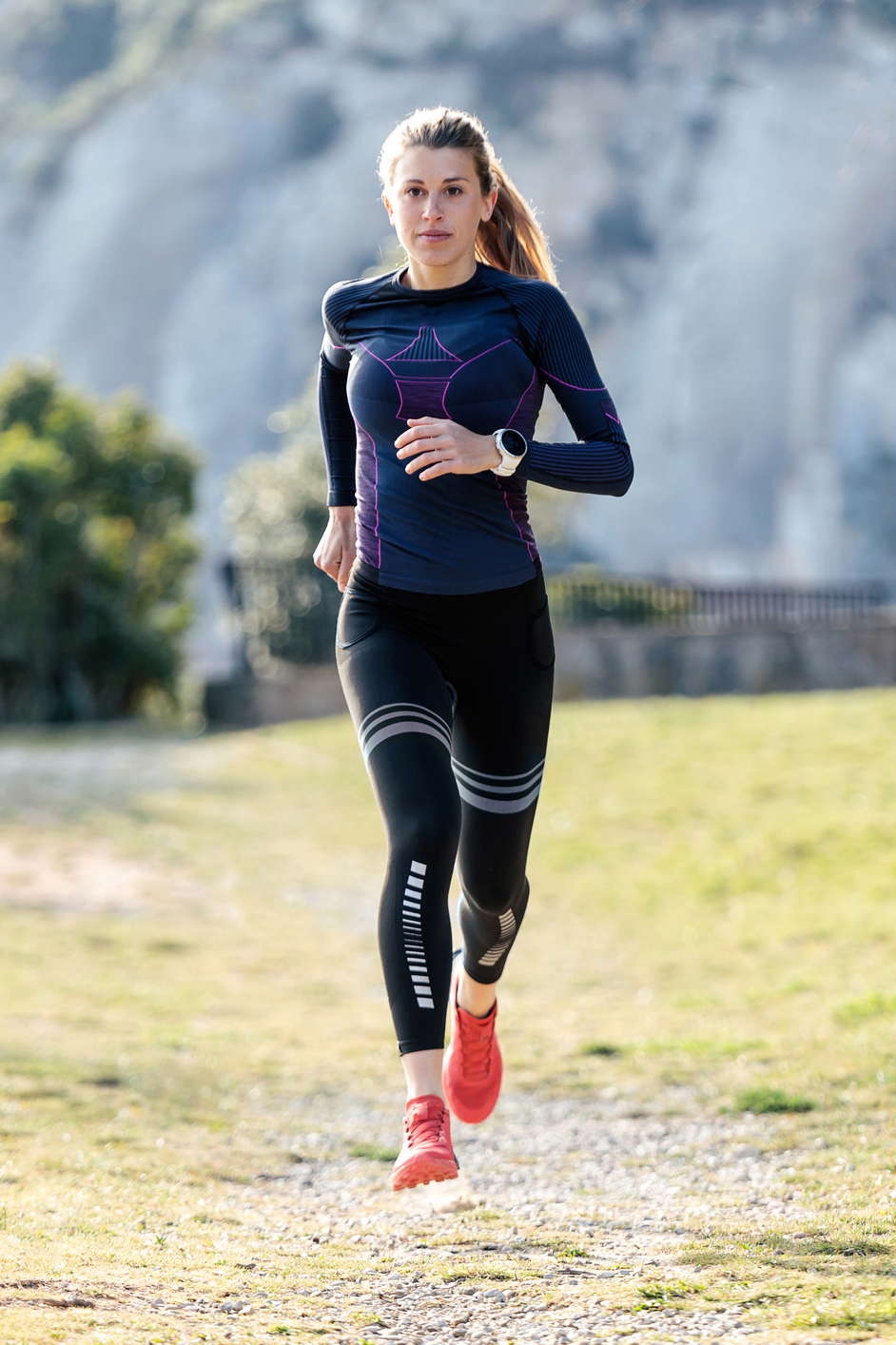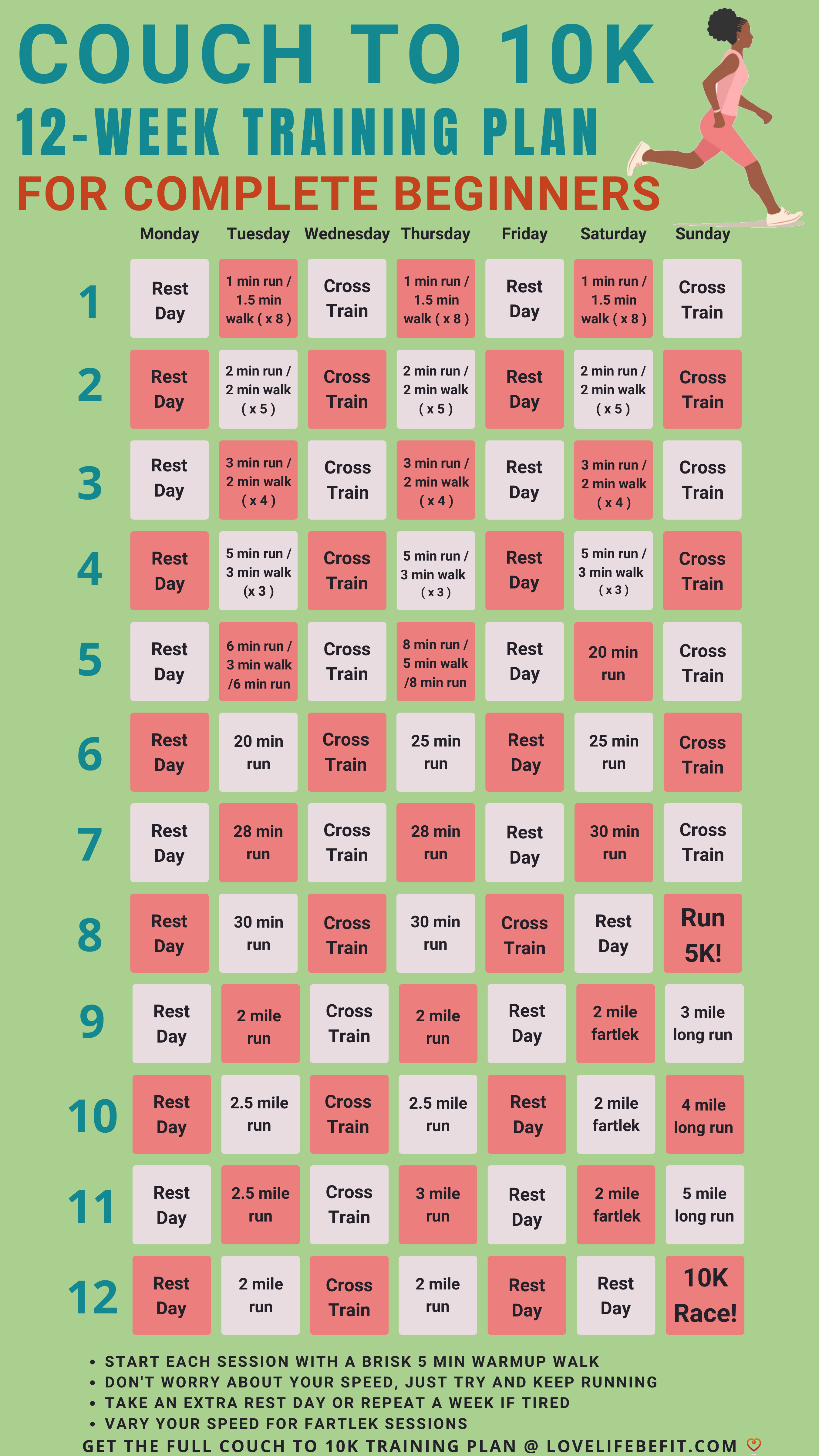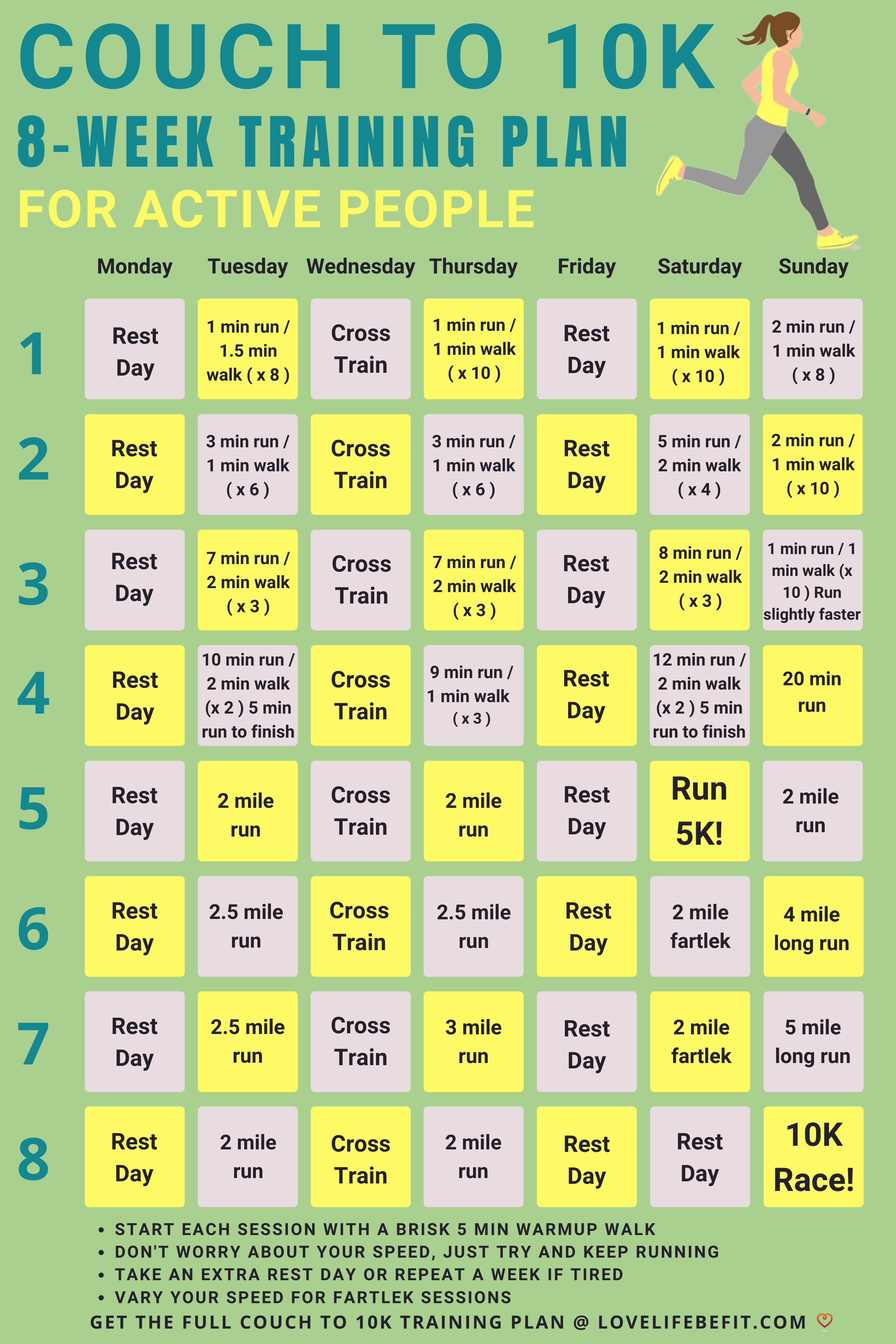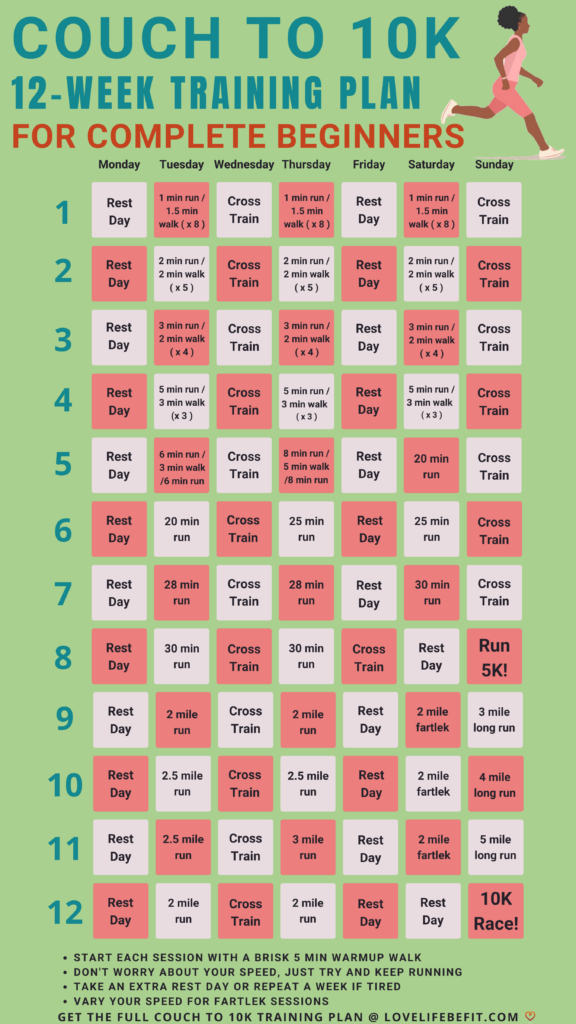Couch To 10K Training Plan For Beginners By UESCA Certified Coach
Ready to take on a big challenge? Never mind Couch to 5K, this is Couch To 10K. Twice the distance and twice the kudos!
Following our Couch To 5K plan is a tried and tested way to start running but we realize some people want more. Taking on Couch To 10K means you’ll be running continuously for an hour or more by the end of the program. That’s a big step for new runners.
So who is Couch To 10K for and how long does the training plan take?
We’ve put together two different Couch to 10K training plans:
- Couch To 10K in 12 Weeks for completely new runners with little or no running background.
- Couch To 10K in 8 Weeks for active people. You may not be a runner or it’s a long time since you last ran but you already have some fitness from other sports.
Jump ahead to the training plans or find out everything you need to know about Couch To 10K from how to train to how to lose weight and tips for success.

How Many Miles Is A 10K?
If you’re not used to the metric system, 10K can be a bit of a mystery. The “K” stands for the metric unit of a kilometer, making 10K represent 10,000 meters.
If you’re more used to using miles:
10K in miles is 6.2 miles.
Obviously, it’s twice as far as running a 5K, a more typical target distance for beginner runners.

Why Run 10K?
If most people start running with Couch to 5K, why put yourself through a Couch To 10K program?
Both are popular race distances. Couch To 5K, also known as C25K is well-known as a program to get people off the sofa and running their first 5K race. It’s a free training schedule and it’s highly effective for people who rarely exercise.
So why take on a Couch to 10K program instead?
It’s a bigger challenge
Some people don’t want to take the easy option in life. It takes something extraordinary to be fully motivated.
While all your peers are aiming for 5K, you’re heading for a bigger target – 10K. It sounds better, doesn’t it?
It will also take most new runners at least an hour to run 10K. While you can stagger around a 5K with little training, hitting the 10K mark makes you a proper runner.
No one pulls off a 10K comfortably without following a training plan. Anyone who can run a 10K continuously has dedicated some serious time to their running.
Some people are fitter than they think
Maybe you’re the sort of person who always walks instead of jumping in a taxi. Or perhaps you have the type of job where you spend a lot of time on your feet.
Or maybe you used to do a lot of sports at school and you still head to the gym regularly.
If you’re reasonably fit from other activities, 5K could be too easy. There are a lot of people, especially young people, who will try and run a 5K just to see if they can – without training.
For some people it’s doable. They may wake up with sore muscles the next day and have to walk downstairs backward but 5K is short enough for anyone with some basic fitness and leg strength to finish.
If this sounds like you, Couch To 10K is a better challenge. Showing up at the start line of 10K race without any training isn’t an option. You’ll need to rise to the challenge and put in the work.
You’ll become a proper runner
5K is just a stepping stone. At the 10K mark, running continuously for over an hour, you can call yourself a proper runner.
You’ll be building your runner’s body and your running will open up lots of possibilities. You can train to run faster or take the next step and aim for your first half marathon.
It’s a transformation running your first 10K. It takes real running ability. Getting to the finish line of a 10K requires a tough mix of cardiovascular fitness and running endurance.

10K Run Time – How Long Does It Take?
The State of Running analysis from 2019 shows that runners have never been slower. Here at Love Life Be Fit, we think that’s a good sign – it means more people from all backgrounds, ages, and abilities are giving running a try.
The average 10K time is now around 55 minutes for men and 66 minutes for women. These are average times covering all running experience and ability.
A beginner runner can expect to take between 60 to 80 minutes to run 10K.
For your first 10K, it’s not about the time you take. The aim is to run without stopping and to get to the finish line with good running form.
Your running performance and times will improve as you become more experienced. When you first start running, aim to complete the race distance and stay injury-free.

How Long Does It Take To Complete Couch To 10K?
It takes between 2 to 4 months for most people to complete a Couch To 10K training program.
How quickly you can go from Couch to 10K depends on your starting level of fitness. Some people will make steady progress through our faster 8-week program.
Others will find the 12-week program tough. Never be afraid to repeat weeks if you’re struggling. It’s better to take 4 months or longer to complete the training program than to feel discouraged by progressing too fast.
Who Are These Training Plans For?
These plans are aimed at beginner runners. On the 12-week plan, you’ll go from zero to 5K in 8 weeks. That’s just slightly faster than the standard Couch To 5K 9-week program.
In the remaining 4 weeks, we build up your running endurance until you’re ready to take on 10K.
On the 8-week plan, we whiz through the Couch To 5K training in just 5 weeks and take just 3 extra weeks to build up from 5K to 10K.
The training schedules are open to all new runners but if you haven’t exercised for a while, if you’re carrying a lot of excess weight, or have a pre-existing health issue, we strongly advise getting checked out by a health professional first.
Explain to your doctor what you’re about to do and discuss if the training is suitable. For some people, it’s best to start your fitness journey with walking for weight loss.

Choose Your Training Program
These training programs have been put together by a UESCA Certified Running Coach.
The 12-Week Couch To 10K Plan is for complete beginners who struggle to run for more than a minute or two at a time.
The 8-Week Couch To 10K Plan is for non-runners with some fitness from other sports or activities.
Couch To 10K Weight Loss
Just like Couch To 5K, Couch To 10K is not a weight loss program.
- You’ll get fitter
- You’ll love the changes to your body from running regularly
- Expect new running muscles and more energy.
But you may not lose weight.
Exercise is only one part of the equation when it comes to weight loss. What you eat is just as important.
Lots of people do lose weight when they start running and running is an excellent tool for helping you maintain a healthy weight. So don’t be discouraged.
It’s just that if you reward every run with sticky treats it’s going to be almost impossible to build the calorie deficit you need to lose weight.
For best results when you’re running for weight loss, combine running with eating a healthy diet. When those hunger pangs hit, fill up on whole grains, lean protein, and lots of veggies!

Training For A 10K – Your Running Program Structure
The Couch To 10K Program eases you into running with run/walk intervals. If you’re worried you won’t be able to run – don’t be. The running intervals are so short for the first few weeks that as soon as you’re out of breath it will be time for a walking break.
As you progress through the plan, the running intervals get longer and walking intervals get shorter until you’re running continuously.
How you run isn’t important. When the schedule says run just try and keep moving even if it’s more like a shuffle than a graceful run.
Style and running form can be the focus when you’re no longer trying to catch your breath. Just make sure you don’t start off at an all-out pace!
Keep it slow. Your running speed will naturally improve as you get fitter. Right now all you want to think about is completing your running session. Trying to run at an easy pace for the run intervals and walking at a brisk pace for the walk breaks.
Cross Training
Both plans include cross-training at least once a week. This can be anything from cycling to swimming or even going for a gentle walk.
Try and cross-train for 30 to 40 minutes and don’t skip these sessions. They’re an important part of improving your fitness.
How hard you cross-train will depend on your current fitness level and typical sporting activity. If you’re new to exercise, keep it easy. If you’re already active in other sports, just complete your normal training sessions.
While you’re training for a 10K it’s best not to work hard at any other new activity. But for example, if you already have a hard swim training session once a week – continue as normal.
Find out more about cross-training for runners and why it’s important.
Strength Training
We suggest you complement your training plan with two short strength training sessions a week. These only need to be 10 to 15 minutes long and can be added after running or cross-training sessions.
These bodyweight exercises for runners are ideal but any exercises that strengthen muscles you use for running will help to keep you injury-free.
Help to prevent injuries by working on muscle imbalances. Being equally strong on both sides of your body can be key to injury prevention. Add extra reps to exercises on your weaker side!
Long Run
Once you’ve run your first 5K distance, a weekly long run becomes part of the training plan. The long run helps to improve running endurance, and it’s an important training session in any runner’s toolkit.
Longer distances in training are always at an easy pace. Your average running speed decreases the further you run. So try and set off at a pace you can maintain for the whole run – not just the first mile.
Fartlek
You’ll notice that your training plan has two-mile fartlek sessions for the last few weeks of your plan. What’s this?
Fartlek is the Swedish word for speed play. It’s a good description for a session where you play about with your speed. Vary your pace as you run and run to feel.
Run faster until you need to slow down, then run slowly for a while. Feel the urge to speed up again – go for it. Keep mixing up your pace.
Warm Up
Always warm up before starting to run. We recommend starting each running session with a brisk 5-minute walk.
Rest Days
As a beginner runner, rest days are so important. Your muscles, tendons, and joints need time to recover. Opt for complete rest at least one day a week.
12-Week Couch To 10K Training Plan For Complete Beginners.
Designed for people who can’t remember when they last did any running – if ever! The aim is to get you to the finish line of your first 10K race in 12 weeks.
If you take longer than 12 weeks – that’s okay. It’s always better to repeat a week of the plan or take extra rest days if needed.

Notes on our 12-Week Couch To 10K Training Plan:
- This plan is for complete beginners. If you think you can’t run and you can’t remember when you last ran, this plan is for you.
- Start every run session with 5 minutes of brisk walking. Dynamic stretching is also good.
- Speed doesn’t matter. Just try and get through the run intervals without stopping. It may not look pretty but just keep going.
- Try not to overstride. When you run land with your feet under your body and not out in front. Your running form will improve with practice and as you get stronger, but this one tip will stop you from slamming your heels into the pavement.
- If you’re feeling stiff and sore from running, try some gentle stretching and go for an easy walk. Prop your feet up on a pillow at night.
- If you need it – take an extra rest day or repeat a week.
- Get any persistent niggles checked out by a medical professional.
8-Week Couch To 10K Training Plan For Active People
If you’re already active in other sports, 12 weeks will seem too long to train for a 10K. This plan is for people who already have some fitness, they’re just not runners.

Notes on our 8-Week Couch To 10K Plan:
- This plan is for active people with a base level of fitness from other sports.
- Start every run session with 5 minutes of brisk walking. Dynamic stretching is also good.
- Run slowly. The fitter you are, the more likely you are to try and run too fast. Slow down.
- Try not to overstride. When you run land with your feet under your body and not out in front. Your running form will improve with practice and as you get stronger, but this one tip will stop you from slamming your heels into the pavement.
- If you’re feeling stiff and sore from running, try some gentle stretching and go for an easy walk. Prop your feet up on a pillow at night.
- If you need it – take an extra rest day or repeat a week. or switch to the 12-Week plan above.
- Get any persistent niggles checked out by a medical professional.
Couch To 10K Tips For Success
These are the top tips from our running coaches to get you to the finish line on race day:
#1 Make Sure You Have Good Running Shoes
Being fitted for suitable running shoes will make a huge difference to your progress as a runner. It’s best to visit an independent specialist running store. Always make sure your shoes feel comfortable right out of the box.
#2 Wear Comfortable Clothing
Any fitness clothing you already own will probably be suitable when you first start running. If you’re a woman, make sure you have a supportive high-impact sports bra.
It’s best to wear comfortable running clothing that’s light and breathable.
#3 Start Slowly
We’ve said this before but it’s worth saying again. Run slowly – much slower than you think you should be running. Your speed will improve as you get fitter, your muscles get stronger and your running economy improves. Right now, keep it slow.
#3 Expect Some Muscle Soreness
When you start Couch To 10K it won’t all be easygoing. Following these schedules will be tough, especially if you have no previous fitness background to draw on.
Sometimes you will ache all over and think you’re unable to run. On these days, do your warmup and just try running. If you can get through the first few minutes and your aches start to ease off – it’s okay to keep going.
If you feel persistent soreness, take a rest day. If it doesn’t ease off after a day or two, go and see a physiotherapist.
There’s a difference between feeling a bit sore and pain. Any pain – get it checked out straight away. Don’t push through pain when you’re exercising.
#4 Get Through The First 3 Weeks
Commit to the first 3 weeks of the running plan. Even if you decide on Day 1 that you’d rather be doing ANYTHING but running, get to the end of the first 3 weeks. You may change your mind.
#5 Switch To A Walking Plan
When you’re starting from a low fitness base or you’re carrying a lot of excess weight or you just decide running isn’t for you – switch to a Couch To 5K Walking Plan.
Once you’ve walked a 5K you can move up to a running plan or aim to walk a 10K.
Thoughts From Love Life Be Fit
We’d love to see everyone enjoy running. It’s a natural activity and comes with so many physical and mental health benefits.
Hitting 10K is a major breakthrough for a runner. Get more tips for running your first 10K. Enjoy your race day and celebrate your success.
Once you’ve completed your 10K, set your next running goal! Don’t become someone who completes their first 10K and then returns to the couch. Stay motivated and keep running. It could be running your first half marathon or trying to run faster.
Running 101 Training Guides & Walking Schedules
5K Training Plans
- Couch To 5K Beginner Training Plan
- 12 Week 5K Training Plan
- 10 Week 5K Training Plan
- 8 Week 5K Training Plan
- 6 Week 5K Training Plan
- 4 Week 5K Training Plan
- 5K Training Plan Intermediate





